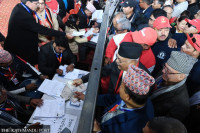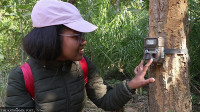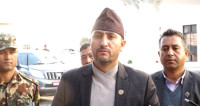National
Judge appointment process hits hierarchy hurdle
Judicial officers object to negotiations between bar and bench to resolve the controversy over changes in regulations.
Post Report
The judges' appointment has become tricky with the Judicial Officers Society objecting to the dialogue between the judiciary and the Nepal Bar Association to resolve the “controversy” over amendments to the Judicial Council Regulations.
The society is an association of officials in the judicial service.
The council revised the regulations in September 2023, adjusting the judges’ ranking. According to the amendment published in the Nepal Gazette on September 20 last year, the chief registrar of the Supreme Court or the council secretary, if appointed a high court judge, would be ranked right under the chief judge of the high court.
The association has demanded that the provision be revoked, describing it as regressive, biased, discriminatory, arbitrary, and unconstitutional and arguing that it contradicts the principles established by the Supreme Court’s verdicts. On September 1, the association started a sit-in demanding that judges be appointed only after revising the provision.
The protest was called off after the leadership in the judiciary on September 2 agreed to form a committee to settle the matter through dialogue. The panel led by Supreme Court’s senior-most justice Prakash Man Singh Raut has a week to submit its report. Ram Prasad Bhandari, a council member, Gopal Krishna Ghimire and Anjita Khanal, president and general secretary of the association, respectively, and Yam Bahadur Budha, secretary of the council, are on the panel.
However, the Society has said that any decision on legal matters must be made in court, not on the streets.
Issuing a statement, the Society said its attention was drawn to the labelling of the regulation as unconstitutional and illegal.
“It is unfortunate that the Nepal Bar Association took to the streets to resolve the matter, ignoring the legal and constitutional course. Interpretation of the law is the judiciary’s prerogative,” reads the statement. “The Nepal Bar Association will be solely responsible for the consequences of forcibly terming the regulation unconstitutional, without seeking the legal and constitutional remedy.”
In December last year, the council appointed Lal Bahadur Kunwar, the Supreme Court chief registrar, a high court judge and ranked him second, after the chief judge of Patan High Court. The association claims that the amended regulation unfairly demotes judges appointed from among lawyers, placing them below career judges in the hierarchy.
The lawyer’s body started the protests as the council was making final preparations to appoint judges across three layers of courts. While four judges’ positions are vacant in the Supreme Court, 16 judges are needed in various high courts.
The five-member Judicial Council, led by the chief justice, nominates judges and justices. The council includes the law minister, the senior-most Supreme Court justice, and two advocates—one each picked by the Nepal Bar Association and the government.
As Chief Justice Bishowambhar Prasad Shrestha and Ram Prasad Shrestha, a council member representing the lawyer's association, retire next month, the council is working to fill the vacant positions without delay.
Now, the judiciary’s leadership seems to be caught between the mutually contradictory demands from the lawyers and the officials.
There is a practice to fill around half the vacant judge positions from among lawyers. However, Chief Justice Shrestha gave them less priority, which was also a reason for the protest.
In January, 26 district court judges were promoted to high court positions. Four joint secretary-level officials from the judicial service were also picked as high court judges. But only nine lawyers were appointed judges. The association had demanded that half the judges be appointed from among the lawyers.
In the judicial hierarchy, those appointed to the high court from the lawyers’ category are ranked below those promoted from among district court judges or those picked from the judicial service.




 19.12°C Kathmandu
19.12°C Kathmandu














